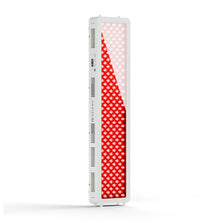Red light therapy (RLT) is a well-known treatment for a range of health conditions, such as skin rejuvenation, anti-aging, reduced inflammation, and promotes wound healing. Yet for RLT to work effectively, an often forgotten factor — the body’s mineral balance — must be optimized to achieve maximum effects. Knowing how minerals affect red light therapy effectiveness allows you to improve the benefits and optimize your experience.

Why Minerals Are Essential for Red Light Therapy Success?
How do Minerals Enhance Cellular Response to Red Light?
Red light therapy stimulates the processes that help cells to heal and repair. When red light reaches the skin, it penetrates down to reach the mitochondria — our cells’ power plants. This exposure improves the mitochondria’s capacity to generate adenosine triphosphate (ATP), the substance that powers cellular processes. This process is fortified by minerals, especially those involved in enzymatic reactions and cellular energy production [1].
Minerals, such as magnesium, calcium, and zinc, are vital for establishing the environment for ATP production, while minerals such as copper are involved in redox reactions and the function of antioxidant enzymes. If we do not have enough of these minerals available, then red light therapy will not be able to work as effectively and cannot provide the very best results.
Key Minerals Linked to Red Light Therapy Outcomes
A number of minerals have been shown to enhance the output of red light therapy, either directly or indirectly:
Magnesium: Essential for cellular energy production; helps convert glucose into usable ATP. Magnesium also helps to support nerve function and muscle relaxation — both essential for reducing inflammation and stimulating healing.
Calcium: Vital for communication between cells, calcium is involved in cell signaling that allows them to respond appropriately to red light.
Zinc: A key cofactor for antioxidant enzymes such as superoxide dismutase (SOD), zinc protects cells from oxidative damage resulting from red light therapy and other environmental stress.
Copper: Works with zinc to maintain antioxidant defense and promote collagen production, essential for wound healing and tissue restoration.
How Mineral Deficiencies Undermine Red Light Therapy?
Signs Your Mineral Levels Might Be Too Low
Low mineral levels can not only be harmful but can also reduce the effectiveness of red light therapy. The following are common symptoms of mineral deficiencies [2]:
- Fatigue, weakness: Deficiency in magnesium or calcium can hurt mitochondria function and make it impossible to produce more energy, limiting therapeutic effects of red light therapy.
- Skin problems, delayed wound healing: Your body needs the trace mineral zinc to repair and regenerate skin cells, so its poor response to red light therapy may be due to a zinc deficiency.
- Muscle cramps, spasms: Deficiencies in magnesium and calcium can create muscle tension or cramps that make it difficult to undergo red light therapy sessions.
-
Increased inflammation, pain: Low levels of minerals such as magnesium, zinc, and copper can lead to more inflammation and oxidative stress that limit the anti-inflammatory effects of red light therapy.

Why Deficiency Blocks Therapeutic Effects?
Mineral deficiencies trap the therapeutic effects of red light therapy, as they are key for essential cellular processes. Minerals such as magnesium, calcium, zinc, and copper are essential for energy production, cellular signaling, and antioxidant defense, for example. If these levels are insufficient, the body’s cells may not respond appropriately to the interaction of light energy and cellular components, limiting healing and regeneration.
A deficiency can also amplify oxidative stress, minimizing the anti-inflammatory benefits of the therapy. Plus, without enough minerals in the body, tissue repair and collagen production can slow down, making recovery take longer. In other words, without these minerals, we are unable to fully utilize red light therapy.
How do Sufficient Mineral Levels Amplify the Effects of Red Light Therapy?
Enhancing Cellular Communication and Responsiveness to Light Energy Through Minerals
Calcium, magnesium, iron, and zinc—these minerals promote proper cell communication and responsiveness to light energy when using red light therapy. Calcium assists in cellular signaling, magnesium assists in energy conversion, and zinc aids enzymatic processes that facilitate healing. Adequate levels of minerals also promote the cells’ absorption and utilization of the light energy, enhancing the therapy’s healing and regenerative effects [3].
Supporting Antioxidant Defense and Reducing Oxidative Stress During Red Light Therapy
Red light therapy is advantageous, but as cells are activated, reactive oxygen species (ROS) can be produced. ROS generate oxidative stress and structural damage to cells. Minerals such as zinc, magnesium, and copper are integral to the functioning of antioxidant enzymes that outmaneuver these destructive molecules.
Zinc, in particular, stimulates the enzyme superoxide dismutase (SOD) that decreases oxidative damage and, in turn, enhances the body’s healing capacity. When your mineral levels are where they should be, your body has the tools to handle oxidative stress during red light therapy sessions to mitigate any adverse effects.
Strategies for Ensuring Optimal Mineral Intake to Maximize Therapy Results
Emphasizing a Mineral-Rich Diet to Support Red Light Therapy Effectiveness
Including foods rich in magnesium, calcium, zinc, and copper will ensure that your body is primed to respond to red light therapy.
Mineral-rich foods to include are:
- Magnesium Leafy greens, nuts, seeds, legumes, whole grains, avocados.
- Calcium: Dairy products, fortified plant-based milks, leafy greens and tofu.
- Zinc: Meat, shellfish, legumes, seeds and nuts.
- Copper: Shellfish, organ meats, seeds, nuts, whole grains.
Considering Safe Supplementation Strategies and Consulting Healthcare Professionals for Personalized Advice
Some health conditions cause mineral deficiencies that hinder the body's ability to heal and lower the effectiveness of red light therapy and similar treatments. Mineral balance can be disrupted by conditions like osteoporosis, digestive issues or chronic stress, all of which can interfere with the action of therapy on your body.
Talk to a professional who can check blood levels of your minerals and make recommendations for the right dietary or supplementation changes to enhance the effects of the therapy and help you with your overall health.
Combining Minerals with Red Light Therapy Best Practices
Timing Your Sessions for Mineral Synergy
To enhance the benefits of your sessions of red light therapy, synchronize your sessions with your mineral consumption. During therapy, the cellular activities will be higher; hence, it will need a constant supply of minerals throughout the day. For example, eating a magnesium-rich meal ahead of a session helps prime your body to respond to red light.
Consistency Over Time: The Synergistic Relationship Between Minerals and Red Light Therapy
Both minerals and red light therapy need to be consistent. For maximal healing benefits, this therapy should be done regularly, with a consistent, balanced intake of minerals. Note that you are creating a long-term synergy between nutritional support of the body and stimulation by the light therapy for your body following through the weight loss phase.
Knowing how to utilize the benefits of minerals can change your experience with red light therapy profoundly, allowing faster and better healing and rejuvenation.
Conclusion
By optimally saturating these minerals, you can maximize the benefits of red light therapy! Important minerals for cell response, magnesium, calcium, zinc, and copper, can help the cell to lead muscle growth and provide protection from free radicals. Optimizing your therapy, taking a mineral-rich diet, and adding supplements, when necessary, will reinforce your therapy and better your results. The effects can be faster and clearer only if therapy and mineral uptake are continuous.
References
- “What Is RLT?” WebMD, www.webmd.com/skin-problems-and-treatments/red-light-therapy.
- Lukaski, Henry C. “Vitamin and mineral status: effects on physical performance.” Nutrition (Burbank, Los Angeles County, Calif.) vol. 20,7-8 (2004): 632-44. doi:10.1016/j.nut.2004.04.001
- Cleveland Clinic. “Red Light Therapy: Benefits, Side Effects & Uses.” Cleveland Clinic, 1 Dec. 2021, my.clevelandclinic.org/health/articles/22114-red-light-therapy.















 Small
Small

 Moderate
Moderate

 Moderate
Moderate

 Moderate
Moderate

 Full
Full



